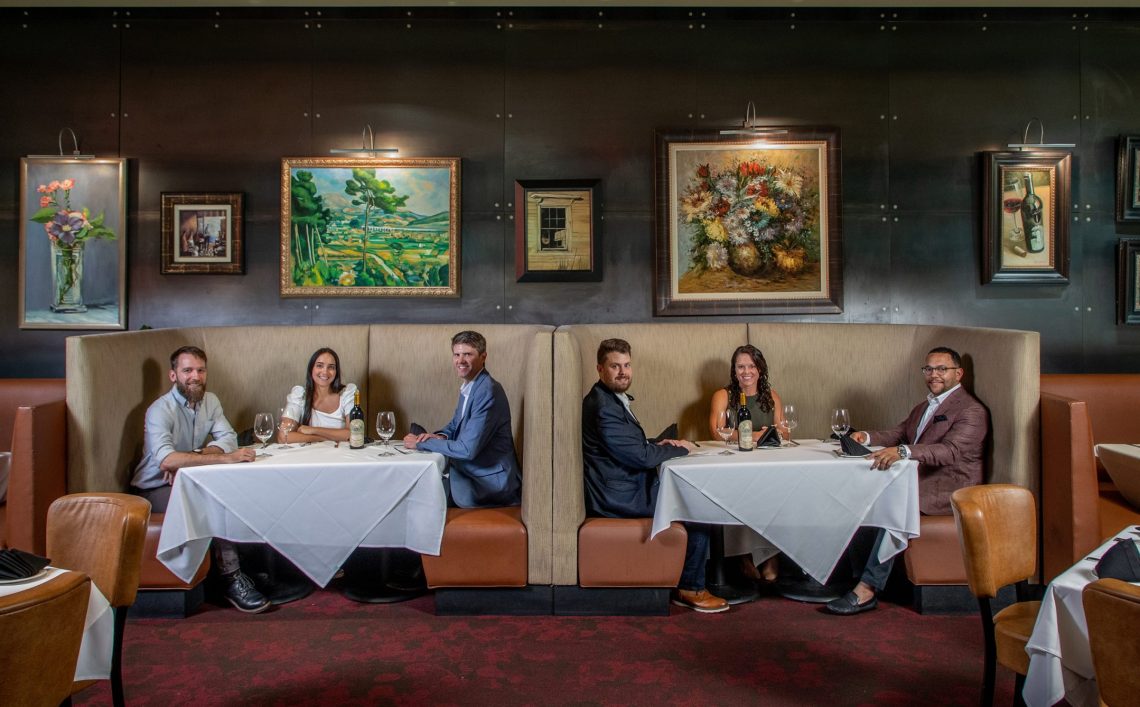Associate Architect, Interior Architect
SmithGroup | Chicago, Illinois
The pursuit of happiness has become a familiar phrase for many. Yet, its philosophical roots took hold long before it became embedded into documents and local vernacular. For Raquel Guzman Geara, AIA, that pursuit in terms of architecture can help facilitate and enhance the human experience. When rooted in key principles like empathy, inclusivity, and delight, architecture has the ability to not only shape daily life, but also to support people on their individual and collective paths toward happiness and well-being.
“Architecture was not always the first thing in my mind growing up, but I did have a passion for art and design. Anywhere I went, I would find beauty in most of the things I saw whether they were natural or manmade, and the older I got, the more I started analyzing the spaces I used to visit. I would study how people moved around them, how a building would shape the skyline, how I navigated my city, and I also started realizing my daily life was shaped by all of the places that surrounded me and it could either create a great experience or a bad experience,” Guzman Geara said. “Architecture shapes our daily lives. It changes how you see your surroundings and how you navigate spaces; it changes society, and it helps shape our beliefs and culture.”

It was this shape of space and the powerful potential of design that inspired Guzman Geara to initially pursue academic study in interior design and theater design at the Savannah College of Art and Design, or SCAD, of Savannah, Georgia. Guzman Geara, who is from the Dominican Republic, said that studying in the U.S. had always been a dream that she worked hard at since there were more opportunities to study different careers related to the design fields. She noted her initial interest had been in the interior of space and shaping people’s experience through design, which had been largely informed by her own time in the Dominican Republic, where growing up the interior was prioritized over the exterior buildings and shape of skylines.
“But then I got into school and started talking to people and learned that with architecture I could do all of those things I loved and go all the way from the macro to the micro scale,” Guzman Geara said. “[SCAD] is not necessarily a technical school, so from the get-go I was exposed to so many fields of art. Originally, I had been thinking interiors and theater design, but then I saw that with architecture—which I call the mother of all design disciplines—I could start by shaping what the exterior was going to look like, what a city could be seen as, and move into architectural interiors, where I could go inside those spaces and [explore] how is this person going to walk around a space, how are they going to perceive it, and is it going to change the way they feel?”
While at SCAD, Guzman Geara also studied abroad in Lacoste, France—one of the art and design institution’s three locations—and earned both a Bachelor of Fine Arts in Architecture and a Master of Architecture degrees, with a background in planning and architectural and design strategies. It was an experience she credits for instilling in her the ability to work collaboratively with people of different backgrounds, find quick and creative solutions, and help to shape a work ethic that translated well for the workplace, as she then went on to become a licensed architect and join the award-winning, global, integrated design firm of SmithGroup. Now an Associate Architect and Interior Architect at SmithGroup Chicago, Guzman Geara brings her passion for human-centered design to workplace, higher education, and science and technology-related projects.
“My design philosophy is ultimately rooted in empathy. I’m a big believer in making the effort to understand others. I think great design is derived from empathy and it is a key skill that any architect should develop. If you analyze it from the project side, you have to understand the user and be very realistic about how the spaces will be used. It might not be the most attractive design to you, but it is going to have the most important qualities to them, and regardless, as an architect you can still make it thought-provoking and beautiful,” Guzman Geara said.
“I also think it is really critical to understand all of your teammates, because the best projects and the best leadership comes from a team where you understand who you are working with, why someone is making a decision, and why someone reacts to you the way they do. I think empathy goes both ways,” Guzman Geara added.
She noted that one way empathy can be applied in the design process is being very intentional about community engagement and holding workshops in which the users, the community, and those impacted by the project are brought to the table. While simple in theory, Guzman Geara said it is oft-skipped step and can result in losing the feeling or that human touch in a project.
“Everything goes back to people. They are the root of my existence in my job. I want to help others. I want to solve problems. It’s about getting to know them, trying to help them, and working and collaborating with them—and the same with all the organizations I collaborate with. I just think that humans are so intriguing and impressive,” Guzman Geara said. “Everything has a solution; you just need to find it, you just need to get creative, and when you do, it is one of the most rewarding feelings.”
For Guzman Geara, whose day-to-day fluctuates from client presentations and user engagement to creative exploration and construction details, it is about more than just using the right and left brain, the technical and the creative, that inspires her in her work, but rather the people and the chance to give back to a much larger community. In addition to her role at SmithGroup Chicago, Guzman Geara is also a founding mentor and executive board member of Arquitina, a nonprofit organization helping Latina women get their architect’s license; the co-chair for AIA Chicago Young Architect Forum, or YAF, a community for emerging professionals in the architecture and design industry; the Young Architect Illinois Representative for AIA YAF National; and serves on the AIA Illinois Board.
“I’ve always been of the mindset that as architects and as humans we have to give back to the community. It is our duty. We were lucky enough, privileged enough, to go to school and have this career, so we should be paying it forward. At the same time, I also enjoy connecting with people. If I was only doing my job, I would be siloed, I would be very one-sided to what the world looks like, so I like to go out to see what there is beyond my job,” Guzman Geara said.
From hosting portfolio reviews for students, participating in conference panels, and networking with representatives from other states at a national level, to learning how the state and city work together, and advocating for diversity and inclusion in the field, Guzman Geara said it has been an eye-opening and fulfilling experience for her—and she holds a special place in her heart for her work with Arquitina. As a professional leadership and licensure initiative, Arquitina is committed to raising the one percent of licensed Latina architects in the country and has since developed online cohorts, mentorship planning committee, In Persona meets, and fundraising events, like its recent Latin-inspired Carnivàle.
The organization quickly gained interest from women across the country from San Francisco to New York and has since become a licensed 501(c)3 organization that has partnered with a number of other organizations in Chicago. Guzman Geara noted she was recently part of its fundraising committee that helped raise $25,000 that went toward study materials and exam fees, and as the organization looks to the future, it is now exploring how to maintain its nationwide reach with a local community feel.
“I’m very passionate about Arquitina. We are all new to this, so we are trying to figure out how we can be an organization that is nationwide but also feels very local to each state. We want to keep those mentorship cohorts, but now we are also looking at how can we do local events, such as volunteering, drives, and networking,” Guzman Geara said.
“I want architecture to be more accessible to those who want to study it, because I think we lose so much great talent to other fields, because it is such an expensive career,” Guzman Geara added.
In terms of her own architectural path, it was an intensive one in which she spent the last 12 years navigating a Green Card, or Permanent Resident Card, process that would allow her to live and work permanently in the U.S. upon completing her academic studies. It was a process that she noted made her feel more like a number than a person and required her to show without a doubt that she had an extraordinary ability in the field without taking away another resident’s job.
“It is a very hard subject to deal with. I did all my studies, my seven architecture exams to become licensed, so I basically was putting a lot of effort into staying here while waking up every day thinking they might send me back, because you are not assured. I have had a lot of friends who unfortunately don’t get the lottery after they’ve been working and studying here legally and have to go back to their countries and it is not as easy to start again as adult in a society that doesn’t work the same way; where I could not be the architect that I am today,” Guzman Geara said.
“It was a very hard process and my hope is that if someone reads this, I want them to feel like they can reach out and ask questions about it. A lot of us are going through the process and it is always better to have someone to talk to. I just got it last year, I couldn’t be happier, but I haven’t forgotten the journey and what it means to have advocates or people in your corner,” Guzman Geara added.
While at SmithGroup Chicago, Guzman Geara has worked on projects like Promega Corporation’s Kornberg Center in Fitchburg, Wisconsin; Wayne State University Mike Ilitch School of Business in Detroit; ASML offices in Phoenix; Wyss Institute at Harvard University, Boston; and the new SmithGroup Chicago Office. Throughout, she has observed challenges and opportunities that often go hand-in-hand with each other, like sustainability and resilient architecture, and inclusive design and managing diverse teams. Guzman Geara is also very passionate about advocating for equality, diversity, and inclusivity, noting on the topic:
“The U.S. is a melting pot. This is an opportunity to start understanding the barriers that a wide variety of people are facing. We can start challenging the idea of what is normal, because there is just not a normal anymore, and thinking about inclusivity, it is just considering how different people interact with the world, not only [from a] disability [standpoint], but also age, gender, size, sexuality, income, language, culture, how they were educated, and influenced,” Guzman Geara said.
“There is no way to design for every single person, but that roots back to getting to know your user: what are the biggest challenges they are facing and how can you design for that?” Guzman Geara added.
She also noted as more firms intentionally look to foster diverse teams, the challenge is to then empower all voices to share their insights and become leaders, learning to appreciate the different backgrounds, perspectives, and learning curves each person may bring to the table. It is about hiring diversity not just for the sake of it, but for the potential growth and to have teams that can better represent all members of the community.
“But I think it is beautiful, because when you are working with someone who is different from you, they are challenging your brain, they are challenging you to overcome what you think is the right solution,” Guzman Geara said.
For Guzman Geara, whose affinity for architecture is about shaping space and the people who use it, it is a vocation and a passion that at its core places the human experience and empathy first. To her, it has the ability to shape lives, to inspire students to continue going to school, it is powerful and emotive, and it has an incredible legacy that offers a creative exploration toward a better future.
“Architecture has been there since the dawn of civilization. Stripped down, it is one of the most practical and functional things a human needs, and that is what I find fascinating. From the simplest point of view, architecture is an answer to culture and society,” Guzman Geara said.
“History is great, we can learn from it, but we shouldn’t always design to what we studied or what we know. The problems we have today are not the problems we had in the past. Design is everything. It is so powerful. Design creates emotion, it evokes meaning, it evokes passion,” Guzman Geara added.
Text: R.J. Weick
Photography: M-Buck Studio LLC
First published in Great Lakes By Design: Architectonics, Volume 7, Issue 6






